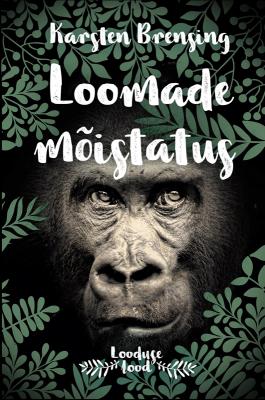Loomade mõistatus: mida nad mõtlevad, mida nad tunnevad. Karsten Brensing
Чтение книги онлайн.
Читать онлайн книгу Loomade mõistatus: mida nad mõtlevad, mida nad tunnevad - Karsten Brensing страница 9
 S. E., Zabel, C. J., Yoerg, S. I., Weldele, M. L., Drea, C. M., Frank, L. G. Social facilitation, affiliation, and dominance in the social life of spotted hyenas. Annals of the New York Academy of Sciences (1997) 807, lk 175–184.
S. E., Zabel, C. J., Yoerg, S. I., Weldele, M. L., Drea, C. M., Frank, L. G. Social facilitation, affiliation, and dominance in the social life of spotted hyenas. Annals of the New York Academy of Sciences (1997) 807, lk 175–184.
20
http://www.spiegel.de/spiegel/print/d-122760764. html.
21
Izzoab, T. J., Rodriguesabc, D. J., Meninad, M., Limaa, A. P., Magnussona, W. E. Functional necrophilia: a profitable anuran reproductive strategy? Journal of Natural History (2012), 46. kd, nr 47–48.
22
Oelze, V. M., Fuller, B. T., Richards, M. P., Fruth, B., Surbeck, M., Hublin, J. J., Hohmann, G. Exploring the contribution and significance of animal protein in the diet of bonobos by stable isotope ratio analysis of hair. Proceedings of the National Academy of Sciences of the United States of America (2011)108 (24), lk 9792–9797.
23
Manson, J. H., Perry, S., Parish, A. R. Nonconceptive Sexual Behavior in Bonobos and Capuchins. International Journal of Primatology (1997) 18 (5), lk 767–786.
24
De Waal, F. B. M. Bonobo Sex and Society, Scientific American Special Edition (2006), 16. kd, nr 2, lk 14–21.
25
Surbeck, M., Deschner, T., Schubert, G., Weltring, A., Hohmann, G. Matecompetition, testosterone and intersexual relationships in bonobos (
26
Connor, R. C., Watson-Capps, J. J., Sherwin, W. B., Krützen, M. A new level of complexity in the male alliance networks of Indian Ocean bottlenose dolphins (
27
Cummins, F. S.
28
Buston, P. Social hierarchies: Size and growth modification in clownfish. Nature (2003) 424, lk 145 jj.
29
Dunkel, L. P.
30
Benensona, J. F., Tennysona, R., Wranghama, R. W. Male more than female infants imitate propulsive motion. Cognition (2011), 121. kd, nr 2, lk 262–267.
31
Hassett, J. M., Siebert, E. R., Wallen, K. Sex differences in rhesus monkey toy preferences parallel those of children. Hormones and Behavior (2008) 54 (3), lk 359–364.
32
Kahlenberg, S. M., Wrangham, R. W. Sex differences in chimpanzees’ use of sticks as play objects resemble those of children. Current Biology (2010) 20, lk 1067 jj.
33
Colapinto, J. Der Junge, der als Mädchen aufwuchs. München 2002.
34
Bartels, A., Zeki, S. The neural correlates of maternal and romantic love. Neuro-Image (2004), 21. kd, nr 3, lk 1155–1166.
35
Damasio, A. Human Behavior – Brain trust. Nature (2005) 435, lk 571 jj.
36
Lukas, D., Clutton-Brock, T. H. The Evolution of Social Monogamy in Mammals. Science (2013), 341. kd, nr 6145, lk 526–530.
37
Burkett, J. P.
38
Kosfeld, M., Heinrichs, M., Zak, P. J., Fischbacher, U., Fehr, E. Oxytocin increases trust in humans. Nature (2005) 435, lk 673–676.
39
Reddon, A. R., O’Connor, C. M., Marsh-Rollo, S. E., Balshine, S. Effects ofisotocin on social responses in a cooperatively breeding fish. Animal Behaviour (2012), 84. kd, nr 4, lk 753–760.
40
Oliva, J. L., Rault, J. L., Appleton, B., Lill, A. Oxytocin enhances the appropriate use of human social cues by the domestic dog (
41
Crews, D., Garstka, W. The Ecological Physiology of a Garter Snake. Scientific American (1982) 247, lk 159–168.
42
Piertney, S., Oliver, M. The evolutionary ecology of the major histocompatibility complex. Heredity (2006), nr 96, lk 7–21.
43
Woelfing, B., Traulsen, A., Milinski, M., Boehm, T. Does intraindividual major histocompatibility complex diversity keep a golden mean? Philosophical Transactions of the Royal Society A (2009), 364. kd, nr 1513.
44
Sommerfeld, R. D., Boehm, T., Milinski, M. Desynchronising male and female reproductive seasonality: dynamics of male MHC-independent olfactory attractiveness in sticklebacks. Ethology Ecology & Evolution (2008) 20 (4), lk 325–336.
45
Feromoonide pidu on teatud liiki kohting, kus nuusutatakse riideid, teadmata, kellele need kuuluvad. Kui lõhn meeldib, on esimene samm tehtud.
46
Rozin, P., Gruss, L., Berk, G. The reversal of innate aversions: Attempts to induce a preference for chili peppers in rats. Journal of Comparative and Physiological Psychology (1993) 79, lk 1001–1014.
47
Kish, G. B., Donnenwerth G. V. Sex differences in the correlates of stimulus seeking. Journal of Consulting and Clinical Psychology (1972) 38 (1), lk 42.
48
Byrnesa, N. K., Hayesa, J. E. Behavioral measures of risk tasking, sensation seeking and sensitivity to reward may reflect different motivations for spicy food liking and consumption. Appetite (2016), 103. kd, lk 411–422.